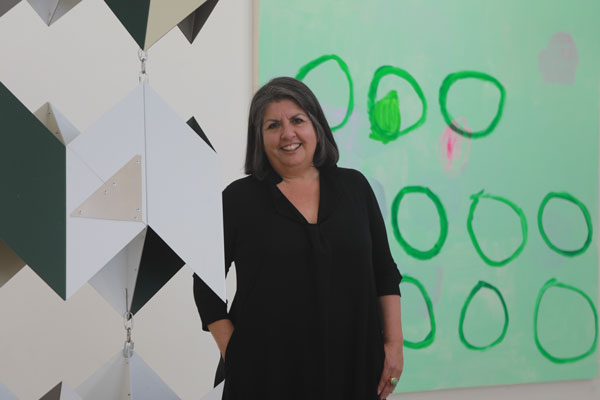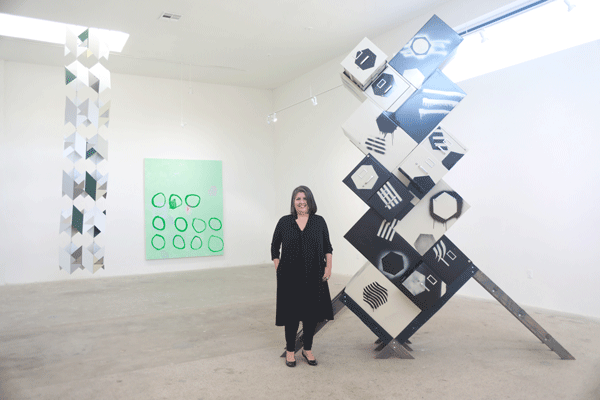This year, the veteran LA gallery ltd los angeles marked the start of its 10th season. In some ways, the gallery’s program looks more like that of a nonprofit than a commercial gallery. They don’t represent artists, per se. Instead of having a roster of 12 to 20 artists who rotate solo exhibitions, with a few group shows sprinkled in between, ltd los angeles works with a broad range of artists, sometimes in solo exhibitions, but mostly in a schedule heavily peppered with group shows featuring edgy work. It’s a venue where emerging artists—quite a few are recent MFAs from schools like Hunter College, Yale and UCLA, such as Jule Korneffel, Ilana Savdie or the drawing collective En Plein Error—often show alongside established ones, such as Skip Arnold, or Jason Meadows.
Festive receptions tend to draw a crowd. There are always drinks and usually some kind of barbecue—at one recent event, a roasted pig fed 200 people. Shirley Morales, ltd los angeles’ founder, sees their program as firmly anchored in an ethos of public engagement and discourse. She relates this back to her own early encounters with the art world: “When I was learning about art, people took the time to explain their programs to me and to walk me through artists’ practices.” Group exhibitions extend the notion of discourse across those practices, opening up a space in which artists’ works engage in lively conversation.

Morales in exhibition space.
Late one morning in early January, I met Morales at the gallery. It anchors a row of faux Spanish Colonial Revival storefronts across the street from the imposing and comparatively palatial David Kordansky Gallery, at the corner of La Brea and Edgewood Place in Los Angeles’ Mid-Wilshire district. Entering through the double wooden doors that angle toward the intersection, I stepped into the modest exhibition space. Before long, Morales walked down from her office upstairs. She launched amiably into conversation as if we had just left off five minutes before.
Inside the gallery’s larger exhibition space, a gentle echo follows the footfalls of visitors. At the back of a second smaller space, which Morales calls “cocooned,” an open stairwell leads to the second-floor office that Morales shares with colleagues Kate Eringer and Lucas Matheson. It’s cozy, with a work station up against the bannister, a wall of bookshelves and Morales’ desk. Art hangs on the walls and small pieces are scattered about, on Morales’ desk and placed selectively along the shelves. “We really believe in the conversations that happen as visitors come in,” she says, commenting on the open design of the office area. On the far wall an eight-foot span of Plexiglas interrupts the drywall, revealing a view of the larger exhibition space below. The film and video screening room just beyond the office features curated programming that is often coordinated with the opening of a new exhibition.
In February, Makayla Bailey, of LAXART, and Matheson organized ltd los angeles’ “Nature is An Other,” a video program featuring a diverse group of artists, including Tony Cokes, Coleman Collins and Anna Lascari. Along with an afternoon of performances by Daniel Gaitor-Lomak, Margaret Haines and noé olivas, it complemented the February group exhibition curated by Eringer, entitled “and I’ll have a pepper-shaker in my cave, so laugh.” Regular performance weekends, video and film screenings and the gallery’s ambitious catalog of exhibition essays support a fabric of diverse programming and public engagement.
Morales came to the art world gradually. “I didn’t go to art school,” she volunteers. Instead, she worked on Capitol Hill. “I was a lawyer—didn’t practice, but went to law school.” She was a legislative assistant for Maryland Congresswoman Helen Bentley in the House of Representatives and on the Merchant Marine and Fisheries Committee. But “it was cold” and art was still off in the future.
“I came to Los Angeles, like everybody else. Trying to get a new life, looking for the sun, looking for open minds,” she says. It was 1987 when she and her husband escaped the nation’s frozen capital. Morales eventually started “doing art stuff” in the late ’90s. But even at an early age, she was turned on to art by visiting the Hirshhorn Museum. In Baltimore, where she grew up, the Walters Art Museum was “like a little jewel box.”
Along the way, Morales studied architecture and design, picking up a certificate at UCLA and studying at SCI-Arc’s Making+Meaning intensive. Eventually, she began visiting galleries and started to get serious about contemporary art.
She remembers an early encounter with several Toba Khedoori drawings. “They moved me so much, and I couldn’t understand why.” She remembers talking about the work with her neighbor Elizabeth Smith, over dinner. The MOCA curator (Smith is now Executive Director of the Frankenthaler Foundation) commented about the kinds of art practices Morales kept coming back to, even though she had no formal training.
Morales asked Smith’s guidance on how to get involved in the art world. “She really encouraged me to keep asking questions, keep inviting artists, keep going to studio visits. I was probably doing two, three studio visits a week for a couple of years. So that’s how I learned,” says Morales.

Morales in gallery with Jason Meadows’ sculpture.
In 2001, she started a residency in her Hollywood Hills home. “I invited Stephen Prina, Connie Butler, Terry Myers, Tom Solomon, Julie Deamer and M.A. Greenstein to come over once a month. I would make dinner and we’d discuss artists,” she says. The garage became a studio, and artists would live in an apartment on the grounds. Their first artist-in-residence was Tomma Abst. “It was a way of learning and offering opportunities for people to come out to LA,” Morales says. “It was a very different LA art world then. It was the first residency in Los Angeles besides the Schindler House.”
After nine years, the residency came to a close, but Morales still had the bug. Curators and artists were coming and going, there were studio visits and talks with dealers. Some of them encouraged her to start her own gallery.
Although she couldn’t have picked a worse moment to start—she opened ltd los angeles in January 2010, in the middle of the recession—money was never the motivating factor, either in terms of risk, or reward.
For Morales, the reason for opening a gallery, like starting the residency, was always to gain knowledge about artists’ practices, to provide opportunities for artists and curators and to make the gallery a public forum. “It’s not just about objects,” she says, “there has to be a context. Otherwise, the work loses something. Space is very important. When you open those doors, it’s like a little gift. And you don’t know what’s behind those doors.”

Morales in exhibition space.
As the market has changed, Morales has adapted. Where ltd los angeles used to travel on the art fair circuit, they are now focused on launching pop-up galleries that typically run about a month. This practice allows them to connect with collectors, curators, nonprofits and museums in other cities. They’ve done Chicago and New York and are developing an international footprint, with one pop-up in Antwerp at a new gallery run by Luc Tuymans, Carla Arocha and Stéphane Schraenen scheduled for April. The exhibition will focus on artists who use their own bodies in their work, with early plans to include Todd Gray, Ilana Savdie and Skip Arnold.
What the next 10 years holds for ltd los angeles is uncharted, but after the influx of so many international mega-galleries into the Los Angeles art world and the shake-out of many small to mid-sized ones, Morales’ programming and forays into other cities seems a remarkably nimble model.
All photos by Eric Minh Swenson.


